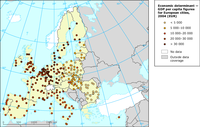
The map shows the GDP per capita for European cites

The infrastructure determinant as a part of adaptive capacity is described through 3 indicators: density of roads networks, number of hospitals beds and sustainable water use index values resulting in 5 classes and presented per NUTS 3 unit

The technology determinant as a part of adaptive capacity is described through 3 indicators: R&D expenditure as % of GDP, number of R&D personnel, number of patent application per resulting in 5 classes and presented per NUTS 3 unit.

The map shows the proportion of women who are elected as city representatives

The map shows the perception of the cities’ population how committed the city’s administration is in its fight against climate change

The map shows the proportion of the city population between 15 and 64 years with a higher education (ISCED level 5 and 6).

The relative changes in population numbers are presented in 9 classes per NUTS 3 unit

Annual average water stress indicator WEI on river basin level for baseline and 2050 period with SCENES scenario Economy First (EcF)

Precipitation deficit in summer (JJA) and winter (DJF) for the periods in the future 2021-2040, 2041-2060 and 2061-2080.

-

The map shows the proportion of the city area (UMZ inside the core city) that would be affected by potential inundation caused by a sea level rise of 1m.

The diagram shows the proportion of cities per country that falls in a particular class regarding the degree of average soil sealing.

The map shows the average soil sealing degree inside the UMZ of European core cities (core city defined in Urban Atlas / Urban Audit). Soil sealing degrees are represented in coloured dots. The city dots are overlaid onto a modelled map displaying the change in annual number of days with heavy rainfall between the reference periods 1961-1990 and 2071-2100.

The diagram shows the proportion of cities per country that fall in a particular class regarding the percentage of potentially flooded area.

Percentage of the city that would be flooded in case water in rivers rises 1 m (only cities > 100 000 hab). The city is defined by its biophysical delineation (Urban Morphological Zone) inside the core city boundaries (Urban Audit). The background shows the relative change in 100-year return level of river discharge. Neither coastal floods nor flood protection measures are considered in the calculations.

The diagram shows the proportion of cities per country that fall in a particular class regarding the share of citizens which are older than 64 years.

The map shows different climate classifications of the areas in the city of Arnheim

The diagram shows the proportion of cities per country that falls in a particular class regarding the share of green and blue urban areas.

The cities are displayed as dots of different colours and sizes. The colours represent the share of green and blue urban areas inside the Urban Morphological Zone of the city, the size of the dots reflects the population density within the core cities’ UMZ. The background map is the result of climatic modelling and represents the number of combined tropical nights (T>20°C) and hot days (T>35°C) for the period 2071 to 2100.

The map is the result of climatic modelling and represents the number of combined tropical nights (T>20°C) and hot days (T>35°C) for the period 2071 to 2100